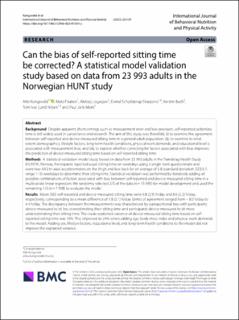| dc.contributor.author | Kongsvold, Atle Austnes | |
| dc.contributor.author | Flaaten, Mats | |
| dc.contributor.author | Logacjov, Aleksej | |
| dc.contributor.author | Skarpsno, Eivind Schjelderup | |
| dc.contributor.author | Bach, Kerstin | |
| dc.contributor.author | Nilsen, Tom Ivar Lund | |
| dc.contributor.author | Mork, Paul Jarle | |
| dc.date.accessioned | 2024-01-15T10:29:22Z | |
| dc.date.available | 2024-01-15T10:29:22Z | |
| dc.date.created | 2023-12-18T08:51:46Z | |
| dc.date.issued | 2023 | |
| dc.identifier.issn | 1479-5868 | |
| dc.identifier.uri | https://hdl.handle.net/11250/3111481 | |
| dc.description.abstract | Background
Despite apparent shortcomings such as measurement error and low precision, self-reported sedentary time is still widely used in surveillance and research. The aim of this study was threefold; (i) to examine the agreement between self-reported and device-measured sitting time in a general adult population; (ii), to examine to what extent demographics, lifestyle factors, long-term health conditions, physical work demands, and educational level is associated with measurement bias; and (iii), to explore whether correcting for factors associated with bias improves the prediction of device-measured sitting time based on self-reported sitting time.
Methods
A statistical validation model study based on data from 23 993 adults in the Trøndelag Health Study (HUNT4), Norway. Participants reported usual sitting time on weekdays using a single-item questionnaire and wore two AX3 tri-axial accelerometers on the thigh and low back for an average of 3.8 (standard deviation [SD] 0.7, range 1–5) weekdays to determine their sitting time. Statistical validation was performed by iteratively adding all possible combinations of factors associated with bias between self-reported and device-measured sitting time in a multivariate linear regression. We randomly selected 2/3 of the data (n = 15 995) for model development and used the remaining 1/3 (n = 7 998) to evaluate the model.
Results
Mean (SD) self-reported and device-measured sitting time were 6.8 (2.9) h/day and 8.6 (2.2) h/day, respectively, corresponding to a mean difference of 1.8 (3.1) h/day. Limits of agreement ranged from − 8.0 h/day to 4.4 h/day. The discrepancy between the measurements was characterized by a proportional bias with participants device-measured to sit less overestimating their sitting time and participants device-measured to sit more underestimating their sitting time. The crude explained variance of device-measured sitting time based on self-reported sitting time was 10%. This improved to 24% when adding age, body mass index and physical work demands to the model. Adding sex, lifestyle factors, educational level, and long-term health conditions to the model did not improve the explained variance.
Conclusions
Self-reported sitting time had low validity and including a range of factors associated with bias in self-reported sitting time only marginally improved the prediction of device-measured sitting time. | en_US |
| dc.language.iso | eng | en_US |
| dc.publisher | BioMed Central Ltd. | en_US |
| dc.rights | Navngivelse 4.0 Internasjonal | * |
| dc.rights.uri | http://creativecommons.org/licenses/by/4.0/deed.no | * |
| dc.title | Can the bias of self-reported sitting time be corrected? A statistical model validation study based on data from 23 993 adults in the Norwegian HUNT study | en_US |
| dc.title.alternative | Can the bias of self-reported sitting time be corrected? A statistical model validation study based on data from 23 993 adults in the Norwegian HUNT study | en_US |
| dc.type | Peer reviewed | en_US |
| dc.type | Journal article | en_US |
| dc.description.version | publishedVersion | en_US |
| dc.source.volume | 20 | en_US |
| dc.source.journal | International Journal of Behavioral Nutrition and Physical Activity | en_US |
| dc.identifier.doi | 10.1186/s12966-023-01541-y | |
| dc.identifier.cristin | 2214607 | |
| dc.source.articlenumber | 139 | en_US |
| cristin.ispublished | true | |
| cristin.fulltext | original | |
| cristin.qualitycode | 2 | |

